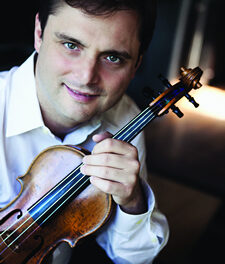An organ recital without a lot of thunder or bombast is not an everyday thing, but the husband-wife team of John and Carolyn Skelton of Boston presented such a program with great skill and musicianship in the season’s first “Fisk on Fourth” recital at St. Paul’s Episcopal Church, part of the East Carolina Musical Arts Education Foundation series for 2010-11. And even without pulse-pounding thunder or bombast, the program had its own brand of musical thrills and excitement, while exposing a small but appreciative audience to some works not often heard; music by such contemporary composers as Jacobus Kloppers and Philip Moore.
In actuality, the program did contain some nice high-energy passages, in Dietrich Buxtehude’s Toccata in F, BuxWV. 156, and the final section of Kloppers’ Dance Suite for Organ Duet, for example. But the program seemed to emphasize more restrained and refined playing than splashy, high-decibel, rattle-the-rafters playing. Not dull by any means but a program of often subtle elegance that brought out a wide variety of colors in the Fisk organ at St. Paul’s Episcopal Church in downtown Greenville, the teaching instrument for East Carolina University.
The Skeltons are well known organists in New England. John Skelton recently retired as director of music at Maple Street Congregational Church in Danvers, Mass., and was organ teacher at the University of New Hampshire and University of Massachusetts for 34 years. Carolyn Skelton was school organist and music instructor at Phillips Academy in Andover, Mass., for more than 30 years. Both earned master’s degrees from the New England Conservatory of Music.
The program opened with “Allegro for Organ Duet” by Philip Moore, who was organist-choir director at York Minster for 25 years, retiring in 2008. This piece is filled with strength and energy, but it also contains some lighter, nicely contrasting treble figures. Moore infused some sections with a denseness of sound and modern yet still accessible chords, and Carolyn Skelton provided an interesting descending line in the pedals.
The Skeltons studied with Anton Heiller in Austria, and John Skelton included Heiller’s short partita on “Freu dich sehr, O meine Seele” a theme and variations whose main melody many might know as “Comfort, Comfort, Ye My People,” with music attributed to 16th century composer Claude Goudimel. The piece contains interesting key shifts, as well as quite busy accompaniments and unusual inner harmonies. Skelton was soloist on a lovely, introspective “Pastorale” by Charles Tournemire (1870-1939), which he said might not yet be published. It contains a large palette of colors and voicings, with emphasis on reeds and lower winds. He also played solo on the Buxtehude toccata, a grand piece whose first movement has long sustained notes under some energetic keyboard work. The second and third sections include fugues with first and second voices played on the keyboard and the contrasting third voice played in the pedals.
Carolyn Skelton played one of the concert’s highlights, the Scherzo for organ by Eugene Gigout. Perhaps not as well known as his toccata, the piece has bright, lively figures that create a flowing melody line. After the piece opens with the main statement introduced in the right hand and then repeated in a lower register in the left, a noticeable mood shift occurs in the middle section, and then the intricate opening keyboard lines of the first movement return to bring the piece to a close. Her articulation and clarity were appealing throughout this most enjoyable piece. She also provided a fine reading of Bach’s Prelude and Fugue in B-minor, S. 544, which opens with a sense of drama and includes some nimble footing in the pedal sections.
The program included two other duets — the allegro section from Samuel Wesley’s Duet for Organ, and Jacobus Kloppers’ Dance Suite for Organ Duet. The Wesley piece offered nice contrasts for the two players, with much busier figures (mainly from John Skelton) contrasting with steadier musical lines (mainly from Carolyn Skelton). The latter, dating from the 1970s, required the two players to be all over the score, if not all over the bench. At times in the opening waltz section, for example, Skelton had energetic trills played under a subtle waltz melody from his wife, and at other times, Carolyn Skelton played the accompaniment to her husband’s more prominent lines. The middle section consisted of a habanera and minuet and returned to the habanera melody before the end. The final section consisted of a highly-charged opening for a polka and then a cakewalk, which had the off-cadence rhythm of a rag before returning to a rousing, splashy ending.












